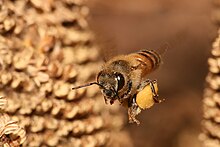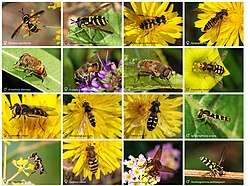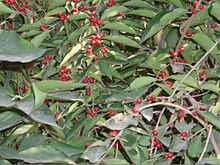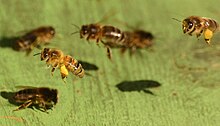
Hi Everybody!!
It is the first feel of Spring Days right now at Kates Cabin. A few of my favorite things showed up in the sunshine: The Bush Honeysuckle bloomed. The first sulphur butterfly appeared with some hungry honeybees. One hoverfly came out also. The flower and the pollinators are a sure sign of Spring. Below you will find info and photos of these first sightings in the new year. The blue sky and sunshine have been great as I have been working outside in the garden. These are the kind of days dreams are made of. Enjoy!





https://en.wikipedia.org/wiki/Phoebis_sennae
Phoebis sennae
From Wikipedia, the free encyclopedia
| Cloudless Sulphur | |
|---|---|
 | |
| Female | |
 | |
| Male | |
| Scientific classification | |
| Kingdom: | Animalia |
| Phylum: | Arthropoda |
| Class: | Insecta |
| Order: | Lepidoptera |
| Family: | Pieridae |
| Genus: | Phoebis |
| Species: | P. sennae |
https://plus.google.com/u/0/photos/117645114459863049265/albums/5968029027558658497



https://en.wikipedia.org/wiki/Lonicera_maackii
Lonicera maackii
From Wikipedia, the free encyclopedia
Lonicera maackii (Amur Honeysuckle or Bush Honeysuckle) is a species ofhoneysuckle in the family Caprifoliaceae, native to temperate Asia in northern and westernChina (south to Yunnan), Mongolia, Japan (central and northern Honshū, rare), Korea, and southeastern Russia (Primorsky Krai).[1]
It is listed as an endangered species in Japan.[2][3] It has escaped from cultivation and become naturalized in New Zealand and the eastern United States; in the forests of the latter, it has become an important invasive species.[4]
It is a deciduous large shrub growing to 6 m tall with stems up to 10 centimeters diameter. The leaves are oppositely arranged, 5–9 cm long and 2–4 cm broad, with an entire margin, and with at least some rough hairs on them. The flowers are produced in pairs, commonly with several pairs grouped together in clusters; they are 2 cm long, two-lipped, white later turning yellow or light orange in color; flowering is from mid spring to early summer.
The fruit is a bright red to black semi-translucent berry 2–6 mm diameter containing numerous small seeds; they ripen in autumn, and are eaten by birds, which disperse the seeds in their droppings. It is fast growing and favours shady habitats such as the forestunderstory, neglected urban areas, and fence rows. It can form extremely dense thickets.[5][6][7]
| Lonicera maackii | |
|---|---|
 | |
| Foliage and flowers in spring | |
| Scientific classification | |
| Kingdom: | Plantae |
| (unranked): | Angiosperms |
| (unranked): | Eudicots |
| (unranked): | Asterids |
| Order: | Dipsacales |
| Family: | Caprifoliaceae |
| Genus: | Lonicera |
| Species: | L. maackii |
| Binomial name | |
| Lonicera maackii (Rupr.) Maxim. | |
It is grown as an ornamental plant for its attractive flowers, and also as a hedge. A number of cultivars have been selected for garden use, including 'Erubescens' with pink flowers, and 'Rem Red' with erect habit.[5]
The flowers are sometimes used by children, who remove the blossom by hand, and pull off the bottom to suck out the sweet nectar in the center. The red berries are mildlypoisonous to humans and should not be eaten.







https://en.wikipedia.org/wiki/Honey_bee
Honey bee
From Wikipedia, the free encyclopedia
Honey bees (or honeybees) are a subset of bees in the genus Apis, primarily distinguished by the production and storage of honey and the construction of perennial,colonial nests out of wax. Honey bees are the only extant members of the tribe Apini, all in the genus Apis. Currently, there are only seven recognised species of honey bee with a total of 44 subspecies,[1] though historically, anywhere from six to eleven species have been recognised. Honey bees represent only a small fraction of the approximately 20,000 known species of bees. Some other types of related bees produce and store honey, but only members of the genus Apis are true honey bees.
The study of honey bees is known as apiology.
| Honey bees Temporal range: Oligocene–Recent | |
|---|---|
 | |
| European honey bee carrying nectar back to the hive, with pollen attached | |
| Scientific classification | |
| Kingdom: | Animalia |
| Phylum: | Arthropoda |
| Class: | Insecta |
| Order: | Hymenoptera |
| Family: | Apidae |
| Subfamily: | Apinae |
| Tribe: | Apini Latreille, 1802 |
| Genus: | Apis Linnaeus, 1758 |
Winter survival[edit]
In cold climates honey bees stop flying when the temperature drops below about 10 °C (50 °F) and crowd into the central area of the hive to form a "winter cluster". The worker bees huddle around the queen bee at the center of the cluster, shivering in order to keep the center between 27 °C (81 °F) at the start of winter (during the broodless period) and 34 °C (93 °F) once the queen resumes laying. The worker bees rotate through the cluster from the outside to the inside so that no bee gets too cold. The outside edges of the cluster stay at about 8–9 °C (46–48 °F). The colder the weather is outside, the more compact the cluster becomes. During winter, they consume their stored honey to produce body heat. The amount of honey consumed during the winter is a function of winter length and severity but ranges in temperate climates from 15 to 50 kg (30 to 100 pounds).[9]
Pollination[edit]
Main articles: Pollination management and List of crop plants pollinated by bees
Species of Apis are generalist floral visitors, and will pollinate a large variety of plants, but by no means all plants. Of all the honey bee species, only Apis mellifera has been used extensively for commercial pollination of crops and other plants. The value of these pollination services is commonly measured in the billions of dollars. Bees collect 66 pounds of pollen per year, per hive.[10]
Honey[edit]
Main article: Honey
Honey is the complex substance made when the nectar and sweet deposits from plants and trees are gathered, modified and stored in the honeycomb by honey bees as a food source for the colony. All living species of Apis have had their honey gathered by indigenous peoples for consumption, though for commercial purposes only Apis mellifera andApis cerana have been exploited to any degree. Honey is sometimes also gathered by humans from the nests of various stingless bees.
In 1911 a bee culturist estimated that a quart(approx. 1 litre) of honey represented bees flying over an estimated 48,000 miles to gather the nectar needed to produce the honey.[11]
Nectar[edit]
Main article: Nectar
Nectar is a liquid high in sucrose that is produced in plant glands known as nectaries. It is an important energetic resource for honeybees and plays a significant role in foraging economics and evolutionary differentiation between different subspecies. It was proposed through an experiment conducted with the African honey bee, A. m. scutellata, that nectar temperature impacts the foraging decisions of honey bees.[12]
Beeswax[edit]
Main article: Beeswax
Worker bees of a certain age will secrete beeswax from a series of glands on their abdomens. They use the wax to form the walls and caps of the comb. As with honey, beeswax is gathered by humans for various purposes.
Pollen[edit]
Main article: Pollen
Bees collect pollen in the pollen basket and carry it back to the hive. In the hive, pollen is used as a protein source necessary during brood-rearing. In certain environments, excess pollen can be collected from the hives of A. mellifera and A. cerana. It is often eaten as a health supplement.





https://en.wikipedia.org/wiki/Hoverfly
Hoverfly
From Wikipedia, the free encyclopedia
Hoverflies, sometimes called flower flies or syrphid flies, make up the insectfamily Syrphidae. As their common name suggests, they are often seen hovering or nectaring at flowers; the adults of many species feed mainly on nectar and pollen, while the larvae (maggots) eat a wide range of foods. In some species, the larvae aresaprotrophs, eating decaying plant and animal matter in the soil or in ponds and streams. In other species, the larvae are insectivores and prey on aphids, thrips, and other plant-sucking insects.
Aphids alone cause tens of millions of dollars of damage to crops worldwide every year; because of this, aphidophagous hoverflies are being recognized as importantnatural enemies of pests, and potential agents for use in biological control. Some adult syrphid flies are important pollinators.
About 6,000 species in 200 genera have been described. Hoverflies are common throughout the world and can be found on all continents except Antarctica. Hoverflies are harmless to most other animals despite their mimicry of more dangerous waspsand bees, which serves to ward off predators.
| Syrphidae | |
|---|---|
 | |
| Sixteen different species of hoverfly | |
| Scientific classification | |
| Kingdom: | Animalia |
| Phylum: | Arthropoda |
| Class: | Insecta |
| Order: | Diptera |
| Suborder: | Brachycera |
| Section: | Aschiza |
| Superfamily: | Syrphoidea |
| Family: | Syrphidae Latreille, 1802 |
Pollination[edit]
Hoverflies are important pollinators of flowering plants in a variety of ecosystems worldwide.[10] Syrphid flies are frequent flower visitors to a wide range of wild plants as well as agricultural crops and are often considered to be the second most important group of pollinators after wild bees. However, there has been relatively little research into fly pollinators compared with bee species.[10] It is thought that bees are able to carry a greater volume of pollen on their bodies, but flies may be able to compensate for this by making a greater number of flower visits.
Like many pollinator groups, syrphid flies range from species that take a generalistapproach to foraging by visiting a wide range of plant species to those which arespecialists and are more selective in the plants they visit. Although hoverflies are often considered to be mainly non-selective pollinators some hoverflies species are highly selective and carry pollen from one plant species.[11] It is thought that Cheilosia albitarsiswill only visit Ranunculus repens.
Specific flower preferences differ between species but syrphid fly species have repeatedly been shown to prefer white and yellow coloured flowers.[12] Non-visual visual flower cues such as olfactory cues also help the flies to find flowers, especially those which are not yellow.[13] Many syrphid fly species have short, unspecialized mouth parts and tend to feed on flowers that are more open as the nectar and pollen can be easily accessed.[14]
There are also a number of fascinating interactions between orchids and hoverflies. The orchid species Epipactis veratrifolia mimics alarm pheromones of aphids in order to attract hoverflies for pollination.[15] Another plant, the slipper orchid in southwest China, also achieves pollination by deceit by exploiting the innate yellow color preference of syrphide.[16]


...this is brendasue signing off from Rainbow Creek. See You next time!

O+O










No comments:
Post a Comment
Hi Everybody! Please say hello and follow so I know you are here! Due to the inconsideration of people trying to put commercials on my blog comment area, I have restricted use of anonymous posts. Sorry that some hurt all.
My public email is katescabin@gmail.com No spammers or trolls